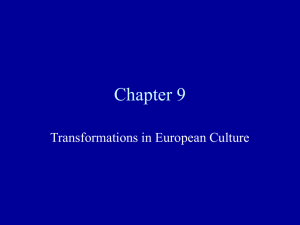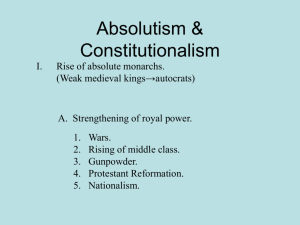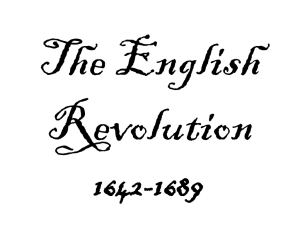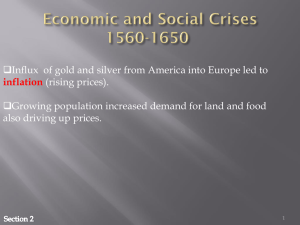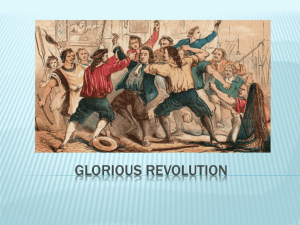Constitutional Monarchy in England
advertisement
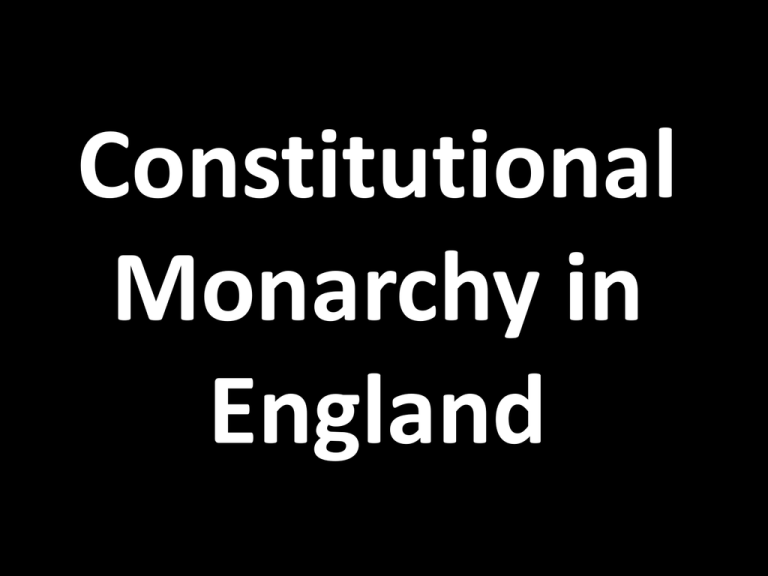
Constitutional Monarchy in England The Tudors • The Tudor dynasty ruled England from 1485-1603 – Henry VIII – Elizabeth I – The Tudors respected and consulted Parliament and the two sides worked well together – In 1603, Elizabeth died without an heir; throne passed to her cousin, a member of the Stuart family King James I • 1566 – 1625 • First king of a “United Kingdom” of “Great Britain” (England, Scotland, & Ireland) • Clashed with Parliament over money and foreign policy, wanted more control as king • Eventually dismissed Parliament King James I & Religion • Persecuted Puritan religious dissenters, causing many of them to flee England (including the Pilgrims who settled in Massachusetts • James also ordered a new translation of the Bible (The King James Version) that reinforced the practices of the Church of England The Gunpowder Treason • Plot by Catholics to blow up King James and Parliament in order to place a Catholic on the throne • November 5, 1605 Remember, remember the fifth of November Gunpowder, treason and plot. I see no reason, why the gunpowder treason Should ever be forgot. • The plot failed, leading to a crackdown on Catholicism Guy Fawkes • 1570 – 1606 • Former soldier assigned to carry out the Gunpowder Plot, but was caught in the act • Tortured into confession • Sentenced to be hung, drawn, & quartered, Fawkes deliberately jumped from the scaffold and broke his own neck • Continues to be a sort of “folk hero” in England for his willingness to take action against a government he did not support King Charles I • 1600 – 1649 • Tried to diminish the power of Parliament and establish himself as an absolute monarch • Violated the Magna Carta and imprisoned his political enemies without trial • By 1628, however, England was broke and Charles was forced to convene Parliament and ask for an increase in tax rates to keep the country running Charles & Parliament • Parliament demanded that Charles agree to not imprison anyone without cause and to respect Parliament’s right to control the tax rate in exchange for raising taxes; Charles agreed • As soon as the new taxes were approved, Charles dissolved Parliament again, this time for 11 years Descent into War • In 1640, a Scottish rebellion forced Charles to reconvene Parliament once again • Parliament quickly moved to arrest and execute Charles’ top advisors and declared that the king no longer had the power to dissolve Parliament • Parliament also raised its own army to stand against the king’s, forcing England into civil war The English Civil Wars • 1642-1649 • Cavaliers (pro-king) vs. Roundheads (pro-Parliament) • Roundheads were led by Oliver Cromwell, a Puritan • King Charles was captured by Roundheads and given a chance to accept a constitutional monarchy, but refused • Charles I was tried, convicted of treason, and beheaded in 1649 – the first European king to be executed by his own people The Commonwealth • • • • • After executing Charles, the House of Commons (the lower house of Parliament) abolished the monarchy, the House of Lords (the upper house of Parliament), and the Church of England Oliver Cromwell was named Lord Protector, the country’s new leader When Catholic Ireland and Calvinist Scotland rebelled; Cromwell put down these rebellions harshly Cromwell quickly became a tyrant, losing the support of the people After Cromwell died in 1658, Parliament softened and invited Charles II (Charles I’s son) to return and resume the throne in 1660 The Strange Tale of Cromwell’s Head • After the restoration of the monarchy, Cromwell’s body was dug up, publicly hung, and then decapitated. • The head was publicly displayed on a pole for 25 years, before being stolen and traded by private collectors until 1960 King Charles II • 1630 – 1685 • Catholic sympathizer • His reign is known as “The Restoration Period” • Despite having many (illegitimate) children, he left no legitimate heir at his death, so he was succeeded on the throne by his brother James King James II • 1633 – 1701 • Had converted to Catholicism and tried to diminish the power of the Church of England • Maintained a standing army with many Catholic officers • Openly promoted the idea of the “divine right” of kings • His oldest daughter, Mary, was a Protestant, but once James produced an heir by his second (Catholic) wife, Parliament became worried that the monarchy might become Catholic for the long-term The Glorious Revolution • Parliament secretly negotiated with James’ Protestant daughter Mary and her husband William III of Orange to replace James as rulers • In 1688, fearing execution, James abdicated and fled to France William III & Mary II • William III (1650 – 1702) • Mary II (1662 – 1694) • In order to take the throne, had to agree to the conditions laid out by Parliament in the English Bill of Rights • William ruled while Mary managed the Church of England • Granted the charter which founded the College of William & Mary in the Virginia Colony in 1693 • Mary died from smallpox with no children, so the Stuart dynasty ended upon William’s death The English Bill of Rights • Parliament is superior to the king • Parliament must be allowed to meet regularly • House of Commons controls the treasury (taxes) • King can not dismiss or interfere with Parliament • King can not suspend laws • King can not be Catholic • King can not maintain a standing army • King can not quarter soldiers in people’s private homes The English Bill of Rights • Citizens get trial by jury • No cruel or unusual punishment • Writ of Habeas corpus – no one can be arrested and imprisoned without being charged with a crime • Citizens have the right to bear arms


